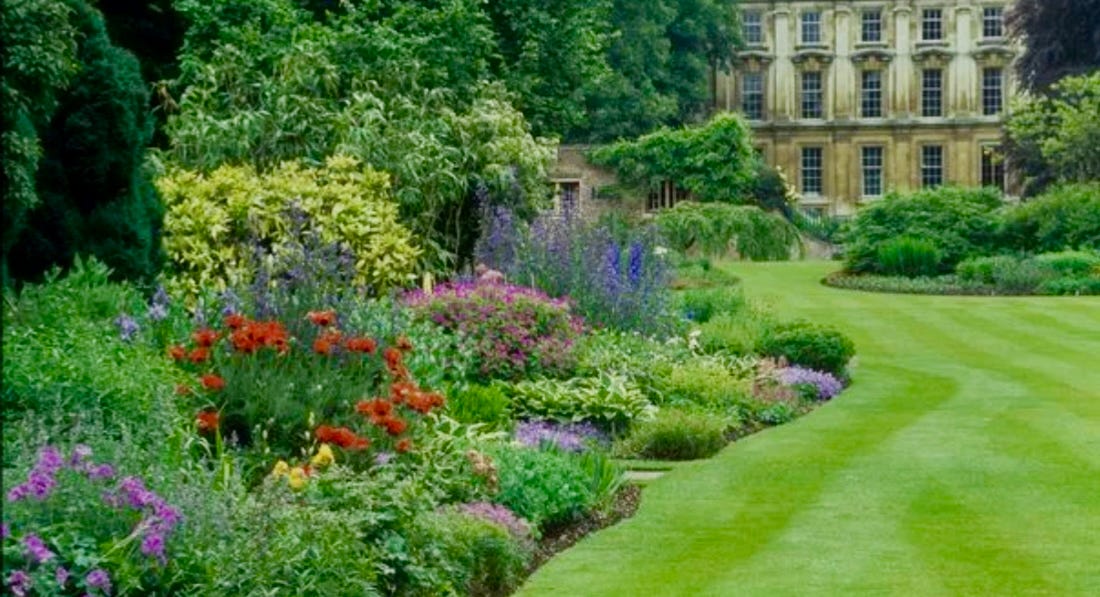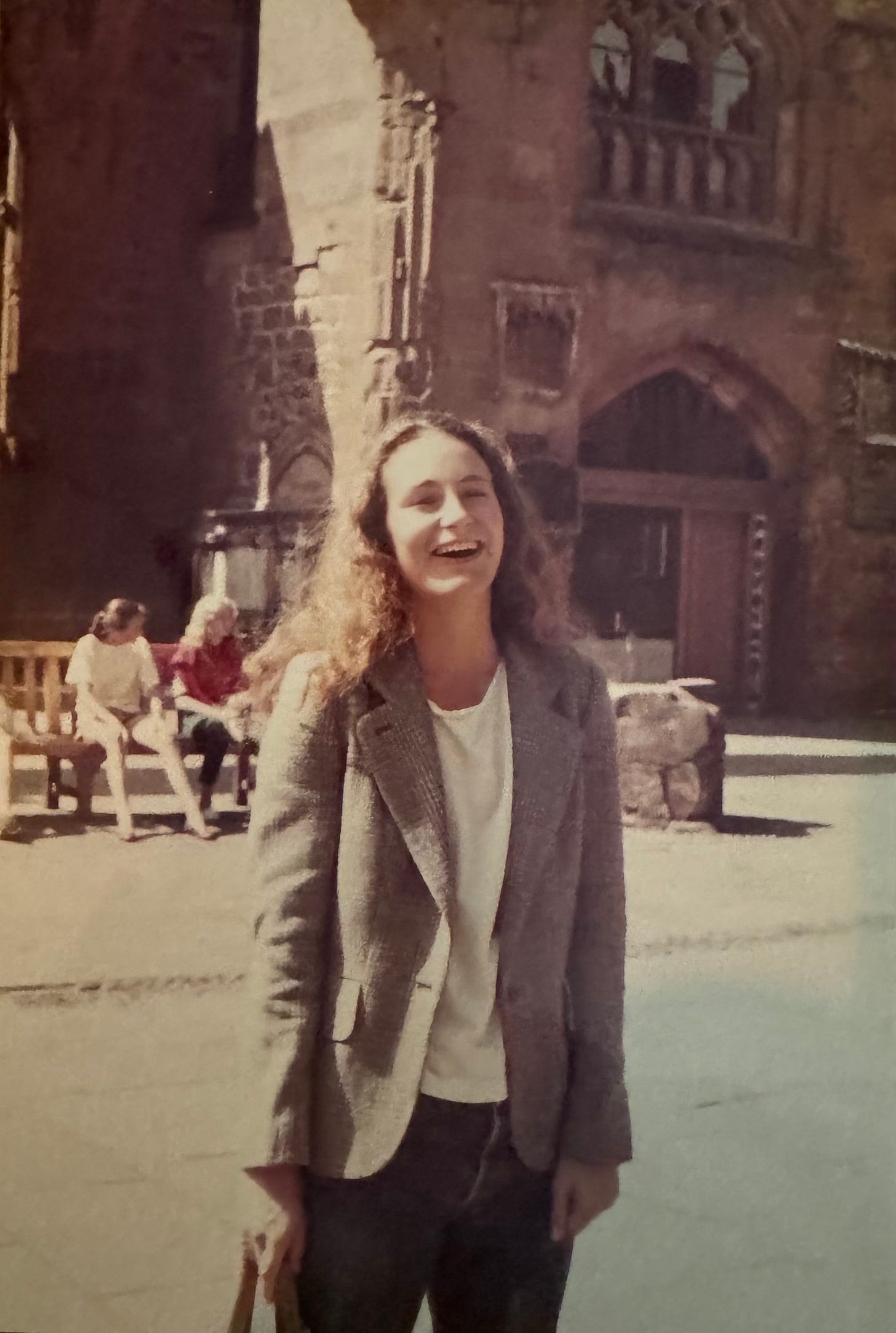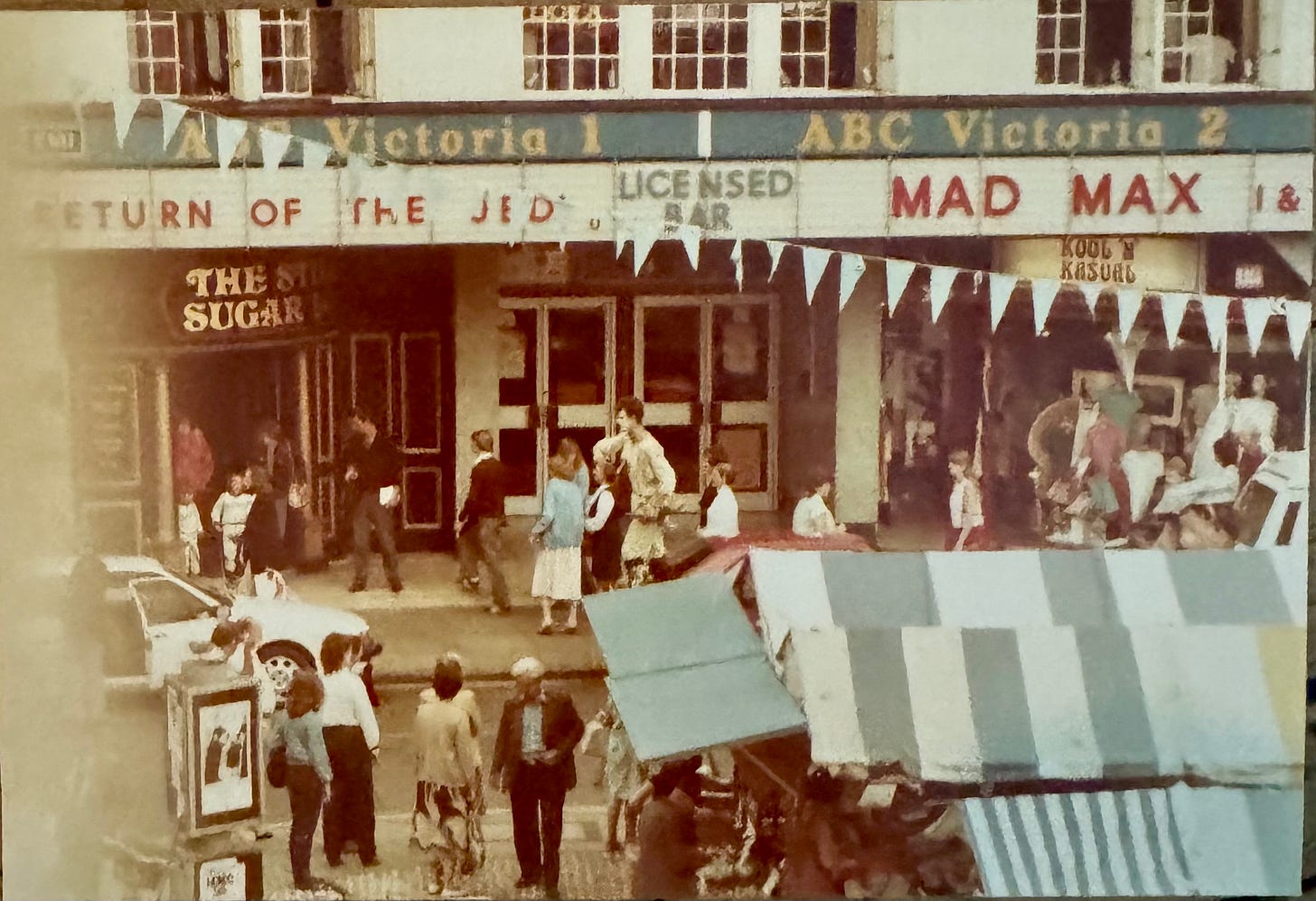I’ve been going through the boxes in my office closet, and I recently found one containing pictures shot in 1983 with my old Konica SLR on Kodak 400 film, which gave everything a grainy, slightly yellowed hue.
I’ve often wondered about this: what am I supposed to do with the photos that are not album-worthy, or that have been left in bags for forty years? I wonder if I should just throw them out — the almost unidentifiable ones, the oversaturated ones, the ones filled with people whose names I now can’t recall, or where my thumb got in the way of the lens — but I can’t, because to do so would be like snipping the wires of time. So I store them in acid-free boxes, put them on the top shelf of my closet, and never look at them.
I distinctly remember it being warm that summer, so warm that the dons who strolled through the college courts were beet-faced and in an obvious hurry to remove their robes. There was no air conditioning anywhere unless priceless artwork was involved, which called for climate control. To stay cool, I spent hours on end moving from chapel to chapel, which were open all day: St. Michael’s was less than twenty yards from where I lived, always empty, and every morning, I stepped inside and started my days very quietly, in stark contrast to how I nearly always ended them.
What began as a disjointed collection of fading and grainy visual memories proved to be much more than reminiscences: I could piece together key facts of my future — my now — from these images.
I got to Cambridge in 1983 as a fluke; there was a new writing program at Caius, and I applied at the last minute, was accepted, packed myself up, and went for a summer term. When it was over, I knew the inside of St. Michael’s and King’s College Chapel well — St. Michael’s was right next door and King’s was directly across the street from where I lived — and further away was Ely Cathedral. Grantchester was a two-mile stroll through lush meadows and at that time, still quiet and sleepy, and not yet the location of a television series of the same name involving a crime-solving Anglican vicar played by James Norton, who would also go on to appear as a mind-bendingly violent psychopathic murderer in Happy Valley, who, among other things, runs over Yorkshire cop Sophie Rundle (several times). When I landed in Cambridge and spent nice afternoons with my friends walking to Grantchester for lunch and a pint (and sometimes a nap in the sun), Norton was three years away from celebrating his first birthday, and Rundle, six.
It was a long time ago.
It was a term of firsts; I was just twenty and had never been to England before, despite having many close friends who lived there and spent their summers working in the States through an organization called BUNAC (British Universities North American Club). Two of my parents’ closest friends lived in Edgeware, north of London, and when I was in single digits they sent me the Enid Blyton books that couldn’t be found in the States. I had just finished my sophomore year at Boston University when I got to Cambridge, where I’d entered a program requiring a once-a-week meeting with the professor I’d been assigned to work with, rather than classes five-days-a-week, often from eight in the morning until nine at night that I’d had in Boston. I hadn’t expected to be studying chamber theater — writing for theater was never on my radar or in my plans — but I did, and adapted Faulkner’s A Rose for Emily for the stage while I was there. That was a first and a last: I haven’t done anything like it since, but I have taught many workshops about the intersection of storytelling and physical nuance, and how to convey in narrative what might be otherwise expressed non-verbally onstage. This just occurs to me now as I sit here drinking my morning coffee: had it not been for this program, much of the work I do today would have possibly never happened.
Firsts: During that summer, I began to notice gardens for the first time. Until then, flowers were just flowers — real or plastic; no difference — and for the most part, not of any interest to me. But my walks all over Cambridge often took hours because at almost every college and outside of the most humble of homes were beds exploding with color. I had family members who were recognized experts at growing certain things: a distant and much older cousin was a peony master, another grew ancient roses, and my uncle every April planted forty pink impatiens in rows so straight that my father said they saluted when my uncle walked past them. In that summer of 1983, I fell in love with Clare College Gardens: the Fellows Garden, the River Beds, the Sunken Garden, and not even getting repeatedly stung could keep me away from them.
I’ve often wondered about this: what am I supposed to do with the photos that are not album-worthy, or that have been left in bags for forty years?
Firsts: That summer, I ate the best fruit of my life, which made what we had in New York pale in comparison. Greengages, gooseberries, sloes, strawberries. Jane Grigson’s Fruit Book had been published a year earlier. We sat down to two full meals a day in a dining hall that my wife, thirty years later on a stroll with me around the courtyards, would say fell out of Harry Potter. I had been told by my parents for years that English food wasn’t great, and I always assumed that it was just another attempt by my dysmorphic mother at watching my weight for me. Even then, in 1983, it was very good, and I came home from England that September longing for lemon posset, gooseberry fool, a decent Scotch egg (or even a bad one), Eton Mess, a full English, a Cadbury Crisp eaten in St. James Park in London, the Cornish pasties sold in a small shop on Rose Crescent which is now long gone (the shop, not the Crescent). I did not, however, miss the lukewarm hangover burgers from Wimpy which, in the early 1980s, were made from God-knows-what or who.
Firsts: An eleven-hour train trip from Cambridge to Glasgow to visit a dear BUNAC friend when the train got stuck in an electrical storm and came to a screeching halt, the fans went out, and we all sat silently watching the cows in the field outside our windows while they watched us back. I was not well on that trip: the night before, I’d gone to The Eagle with some friends and what started as an innocent evening of cider turned into hours of conversation with a Polish dissident who had recently fled martial law in the weeks before it lifted that July. A half pint of cider turned into three turned into five, and when my alarm went off the next morning, I slithered into my clothes and out to Trinity Street, found a taxi to take me to the intercity train which got me to London which then required a change of stations to Euston which put me on a train through Bolton (rerouted; weather) and then through Edinburgh and got me to Glasgow six hours later than it should have. Still very much worse for wear from the events the night before combined with the joys of an unairconditioned train, I was picked up at Glasgow Central by my BUNAC friend and taken to the Parkhouse council house where she lived with her parents and little sister, who still spoke mostly Scots Gaelic over breakfast, and had mapped out an itinerary for me for the days I’d be there. Ill as I was, I managed to eat memorably delicious Indian food that night in a restaurant near George Square and when we stepped outside it was 10 pm, and light as day.
Firsts: I had a very handsome boyfriend who was roughly two heads taller than I, rowed crew for both the college and the City of Cambridge Rowing Club, and was a recently minted doctor and member of the Royal Medical Corps. This came in very handy when I broke my foot late one night while walking up a flight of old, very uneven stairs in my residence after a party in my rooms involving a ridiculous amount of wine, cider, raw milk Stilton from the Cambridge Market just outside my door, and squeeze-tube caviar. Everyone brought something: claret, sherry, port, cider. When the party broke up and I said goodnight to the very handsome boyfriend at the end of the evening and walked him downstairs — the massive iron gate at St. Michael’s Court was locked every night at eleven, and if one had to be let out or let in, it required an embarrassing walk-of-shame call to the reprimanding night porter — and on the way back up I stepped wrong, rolled my foot, and my right metatarsal snapped like a twig.
I somehow managed to hop up three long flights on my left foot (youth is lovely) and got into bed. The next morning I’d forgotten what I’d done the night before and stood up, nearly fainted, and went straight down. I got dressed (no idea how) and hopped back down the stairs and across Trinity Street to the Porter’s Lodge, where I sat on a bench waiting for any of my friends to walk past because the handsome boyfriend was on call. Two did: another student, Cynthia, and her boyfriend Jon strolled by, looked at my foot, gasped, Jon picked me up like a sack of potatoes, and got me to the hospital where I was told that no, in no way would I be hiking in Switzerland two weeks later as I’d planned. They x-rayed my foot and put it in a cast. They wanted to know how I’d done it.
Party, I said.
With what they asked.
Port, I said.
Cynthia sat in the corner of the surgery and looked up from The Guardian. We gazed at each other for a nervous minute, and she went back to her paper.
There was a fair amount of eye-rolling among the staff, and a nurse pulled the curtain closed and said something about young Americans not being able to hold their liquor, and I could not argue with her.
I attempted to pay them and took out the credit card that my father had given me for emergencies.
NHS, one of them said, shaking her head and pointing toward the door.
Firsts: Two women at Caius — one called Mary Frances and the other I have no idea — invited me to join them at the movies one night just across the street from the Cambridge Market (I could see it from my study window, which is how the photo below was shot) and I was thrilled because they were showing Return of the Jedi. We went out before the movie and had a pint, sat ourselves down in the theater, and when the lights dimmed and the credits started to roll, I realized that I was not seeing Return of the Jedi, but John Sayles’ Lianna. Despite the fact of my very handsome, very tall boyfriend, I hyperventilated through most of it and when it was over, went back to my room with a massive migraine. (This should have been a clue.)
In the archival box of photos that I unearthed from my office closet were photos of the market, the theater where Return of the Jedi was definitely not playing that night, a ubiquitous stiltwalker during the Cambridge Festival, a young girl feeding pigeons in front of Ely Cathedral, and Cynthia, who accompanied me to the hospital when I broke my foot and who this year will be married to Jon for forty years.
In 2014, thirty-one years after I left Cambridge, I returned and brought Susan with me. I wanted to show her everything: the chapels, The Eagle, the court where Stephen Hawking still had his office, what a stroll along The Backs is like on a perfect day. (She also had her first posset in a Kensington pub about ten feet from Hugh Jackman who was having dinner with a Spaniel puppy asleep on his lap. Neither of us realized it was Jackman and got up to say hello to the dog. And then we noticed. He was very nice. Both the puppy and Jackman.)
It’s hard to think, though, of the old photos as being anything more than a sieve of time. What began as a disjointed collection of fading and grainy visual memories proved to be much more than reminiscences: at 61 years old, I could piece together key facts of my future — my now — from these images. Assembled like a jigsaw puzzle, these images represent the things that make me me, and that I couldn’t have recognized without the benefit of perspective. The love of gardening, the love of and interest in food, the love of my wife. The possibility in 1983 that I was attracted to women far more than I was to the very handsome, very tall, very lovely doctor would have been terrifying for me; I didn’t want to look there at twenty. The possibility of alcohol everywhere (and granted, there is a lot of alcohol in college no matter where you go to school), resulted in stultifying hangovers and even severe injury that hot summer of 1983; it’s taken me this long to understand what it would ultimately mean for me, and how many years later I would continue to ignore it until my body finally relented. And that is a battle I live with every day, only now I recognize it.
So: if you have bags or boxes or piles of old photos clogging up the works, please don’t throw them away. Please don’t bury them. Spend some time and look closely at them for signs of who you were. And then look again, to see who you are.
Lemon Posset
For those who have never had it, the best way to describe a lemon posset is what would happen if you took lemon curd and made it somehow even creamier, and then anointed it a dessert. I like it very much but Susan loves it — she actually still talks about having it that night in London. According to British Food: A History, possets date to (likely pre) sixteenth century and appear in Hamlet, The Merry Wives of Windsor, and elsewhere, often as a curative.
This recipe comes from Nigella Lawson via Margot Henderson’s 2012 cookbook, You’re All Invited.
Makes 10 servings
8 unwaxed lemons
1½ litres double cream
500 grams caster sugar
Remove the rind from 4 of the lemons, using a vegetable peeler.
Squeeze the juice from all 8 lemons (you should have around 350ml of juice - rolling the lemons on your work service before cutting them in half will yield more juice).
Put the cream into a pan with the strips of lemon rind and stir over a low heat until the mixture starts to steam. Add all the sugar and stir until dissolved.
Turn the heat off and stir in the lemon juice, then leave to settle for 5 minutes.
Strain the mixture through a fine sieve into a large jug, discarding the lemon rind.
Pour into 10 ramekins or small bowls, if you have them, or one medium-sized bowl. Cool to room temperature, then put them into the fridge to set for at least 4 hours or overnight.
Serve with a biscuit such as shortbread, and maybe a little cream.














I’m a few years older than you and this brought back lots of memories of my college days and international travel. I have 8 boxes of all my photos in the basement that I’ve been fearful to go through (prior marriage and lots of memories). It’s not necessarily painful to think of, it’s just that I’ve avoided wanting to go down that rabbit hole rather than looking forward. Your writing here is now helping me see this in a different light and that it might shed some interesting insights. I’m going through some transitions with feeling overwhelmed with work and obligations and having less time for joyful fun— Maybe it’s time to take a look at the younger me and see what it unveils! Thanks for this beautiful post.
Ooh, i love this so much. What a great look back at you at 20, at Cambridge and all it brought, and the younger self who turns out not to be too different from the older self. A riveting read. thank you.